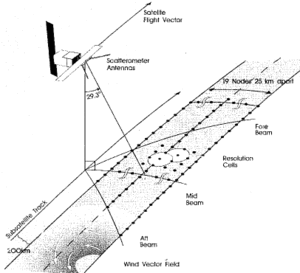- Scatterometer
-
A radar scatterometer is designed to determine the normalized radar cross section (sigma-0) of the surface. Scatterometers operate by transmitting a pulse of microwave energy towards the Earth's surface and measuring the reflected energy. A separate measurement of the noise-only power is made and subtracted from the signal+noise measurement to determine the backscatter signal power. Sigma-0 is computed from the signal power measurement using the distributed target radar equation. Scatterometer instruments are very precisely calibrated in order to make accurate backscatter measurements.
The primary application of spaceborne scatterometry has been measurements near-surface winds over the ocean.[1] Such instruments are known as wind scatterometers. By combining sigma-0 measurements from different azimuth angles, the near-surface wind vector over the ocean's surface can be determined using a geophysical model function (GMF) which relates wind and backscatter. Over the ocean, the radar backscatter results from scattering from wind-generated capillary-gravity waves, which are generally in equilibrium with the near-surface wind over the ocean. The scattering mechanism is known as Bragg scattering, which occurs from the waves that are in resonance with the microwaves.
The backscattered power depends on the wind speed and direction. Viewed from different azimuth angles, the observed backscatter from these waves varies. These variations can be exploited to estimate the sea surface wind, i.e. its speed and direction. This estimate process is sometimes termed ' wind retrieval' or 'model function inversion'. This is a non-linear inversion procedure based on an accurate knowledge of the GMF (in an empirical or semi-empirical form) that relates the scatterometer backscatter and the vector wind. Retrieval requires an angular diversity scatterometer measurements with the GMF, which is provided by the scatterometer making several backscatter measurements of the same spot on the ocean's surface from different azimuth angles.
Scatterometer wind measurements are used for air-sea interaction, climate studies and are particularly useful for monitoring hurricanes. Scatterometer backscatter data are applied to the study of vegetation, soil moisture, polar ice, and global change. Scatterometer measurements have been used to measure winds over sand and snow dunes from space. Non-terrestrial applications include study of Solar System moons using space probes. This is especially the case with the NASA/ESA Cassini mission to Saturn and its moons.
Several generations of wind scatterometers have been flown in space by NASA, ESA, and NASDA. The first operational wind scatterometer was known as the Seasat Scatterometer (SASS) and was launched in 1978.[2] It was a fan-beam system operating at Ku-band (14 GHz). In 1991 ESA launched the European Remote-Sensing Satellite ERS-1 Advanced Microwave Instrument (AMI) scatterometer,[3] followed by the ERS-2 AMI scatterometer in 1995. Both AMI fan-beam systems operated at C-band (5.6 GHz). In 1996 NASA launched the NASA Scatterometer (NSCAT),[4] a Ku-band fan-beam system.[5] NASA launched the first scanning scatterometer, known as 'SeaWinds', on QuikSCAT in 1999. It operated at Ku-band. A second SeaWinds instrument was flown on the NASDA ADEOS-2 in 1993. ESA launched the first C-band ASCAT in 2007.[6]
Contribution to Botany
Scatterometers helped to prove the hypothesis, dating from mid-19th century, of the anisotropic (direction dependent) long distance dispersion by wind to explain the strong floristic affinities between landmasses.
A work, published by the journal Science in May 2004 with the title "Wind as a Long-Distance Dispersal Vehicle in the Southern Hemisphere", used daily measurements of wind azimuth and speed taken by the SeaWind scatterometer from 1999 to 2003. They found a stronger correlation of floristic similarities with wind connectivity than with geographic proximities, which supports the idea that wind is a dispersal vehicle for many organisms in the Southern Hemisphere.
References
- ^ F. Naderi, M. H. Freilich, and D. G. Long (June 1991). "Spaceborne Radar Measurement of Wind Velocity Over the Ocean--An Overview of the NSCAT Scatterometer System". Proceedings of the IEEE 79 (6): 850–866.
- ^ W.L. Grantham, et al., The SeaSat-A Satellite Scatterometer, IEEE Journal of Oceanic Engineering, Vol. OE-2, pp 200-206, 1977.
- ^ E. Attema, The Active Microwave Instrument Onboard the ERS-1 Satellite, Proceedings of the IEEE, 79, 6, pp. 791–799, 1991.
- ^ F. Naderi, M. H. Freilich, and D. G. Long, Spaceborne Radar Measurement of Wind Velocity Over the Ocean--An Overview of the NSCAT Scatterometer System, Proceedings of the IEEE, pp. 850-866, Vol. 79, No. 6, June 1991.
- ^ W-Y Tsai, J.E. Graf, C. Winn, J.N. Huddleston, S. Dunbar, M.H. Freilich, F.J. Wentz, D.G. Long, and W.L. Jones, Postlaunch Sensor Verification and Calibration of the NASA Scatterometer, IEEE Transactions on Geoscience and Remote Sensing, Vol. 37, No. 3, pp. 1517-1542, 1999.
- ^ J. Figa-Saldaña, J.J.W. Wilson, E. Attema, R. Gelsthorpe, M.R. Drinkwater, and A. Stoffelen, The advanced scatterometer (ASCAT) on the meteorological operational (MetOp) platform: A follow on for European wind scatterometers, Canadian Journal of Remote Sensing, Vol. 28, No. 3, June 2002.
Categories:- Satellite meteorology and remote sensing
Wikimedia Foundation. 2010.

